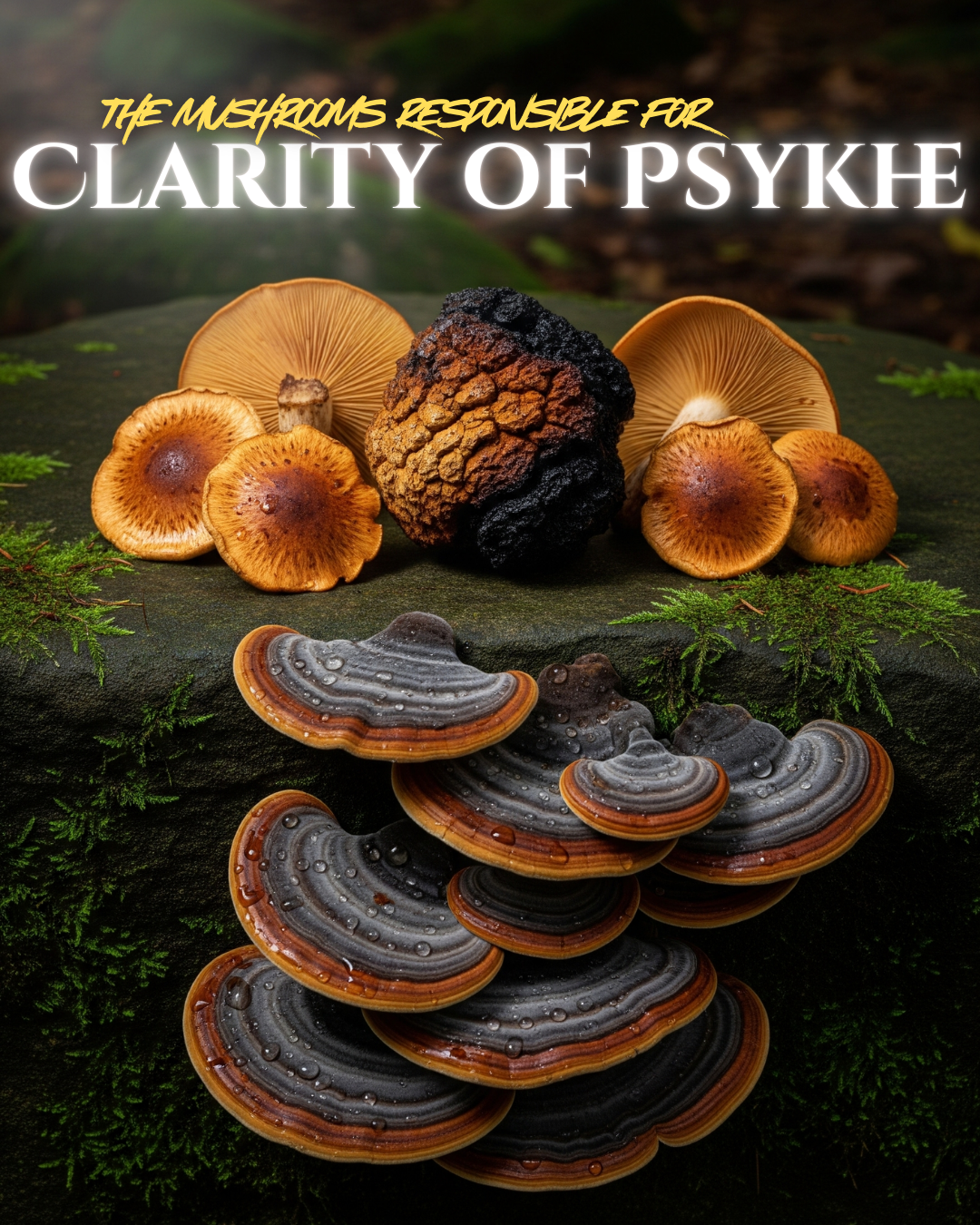Meet the Mushrooms

Share
The Blend Behind Clarity of Psykhe
When we created Clarity of Psykhe, we wanted more than just another formula. We wanted a relic — a blend shaped by history, ritual, and story. Each mushroom in this 10-part complex carries its own lineage, tied to traditions that span continents and centuries.
Lion’s Mane (Hericium erinaceus)
Recognized instantly for its cascading spines, Lion’s Mane has been part of East Asian culinary and wellness traditions for centuries. Its striking form has earned it names like “monkey head mushroom” and “pom pom.” In Psykhe’s story, it represents foresight — the ability to see beyond the fog of distraction.

Reishi (Ganoderma lucidum)
Known as the “mushroom of immortality” in Chinese history, Reishi has been associated with ritual and longevity for more than 2,000 years. Its lacquered, woody surface feels almost like armor. For Psykhe, it is the shield — a reminder of endurance in the face of chaos.

Cordyceps (Cordyceps militaris)
Wild cordyceps were once gathered high in the Himalayas, treasured for their rarity. Their story is one of transformation, growing in unlikely places. Within our blend, they embody vitality — the spark Psykhe draws upon when her journey demands strength.

Maitake (Grifola frondosa)
Maitake, often called the “dancing mushroom” in Japan, grows in layered fronds at the base of trees. Historically valued as food and for its place in local traditions, it represents abundance. In Psykhe’s tale, it becomes the harvest — the bounty found only after perseverance.

Shiitake (Lentinula edodes)
One of the most widely cultivated mushrooms in the world, Shiitake has been used in East Asia for both cuisine and folk tradition for centuries. Its deep, savory richness ties it to nourishment. For Psykhe, it is grounding — a return to essentials when the path becomes overwhelming.

Turkey Tail (Trametes versicolor)
With its fan-like layers and vivid bands of color, Turkey Tail has long been collected across Europe, Asia, and North America. In folk practices, it was often brewed into teas. In our narrative, it represents resilience — the many rings of a life marked by trial and survival.

Chaga (Inonotus obliquus)
Growing like dark charcoal on birch trees, Chaga has roots in Siberian and northern European traditions, often prepared as a tea. Its form is unassuming, but powerful in symbol. For Psykhe, it is the ember — fire carried quietly until the moment it’s needed.

Royal Sun (Agaricus blazei)
Originally discovered in Brazil and later studied in Japan, this mushroom has been tied to ideas of vitality and balance. It thrives in the warmth of the earth. In Psykhe’s journey, it is the steady heartbeat — the rhythm that keeps her moving forward.

Black Fungus / Wood Ear (Auricularia auricula-judae)
Often called Wood Ear for its shape and texture, this mushroom has deep roots in East Asian culinary traditions, frequently appearing in soups and stir-fries. Its history stretches back centuries, valued both for flavor and its striking appearance. In Psykhe’s tale, it symbolizes adaptability — the ability to take many forms and thrive in unexpected places, just as she must bend and endure in her own trials.

White Button (Agaricus bisporus)
The most familiar mushroom to most of us, White Button has been cultivated for centuries and is now one of the most widely consumed fungi worldwide. Its story is one of accessibility — the ordinary mushroom that quietly finds its way into countless kitchens across cultures. In Psykhe’s journey, it represents the everyday foundation, the reminder that clarity is not always found in rare relics but also in the familiar and humble.

Why These Ten?
Each mushroom carries a distinct history. By bringing them together, we’ve built a blend that reflects what Clarity of Psykhe is meant to symbolize: resilience, grounding, foresight, and transformation.
This isn’t about claims or promises. It’s about honoring traditions, respecting origins, and weaving them into something meaningful for today. For Reliquary Labs, that means creating a product that feels like a relic — both modern and ancient, mythic and practical.
In Psykhe’s story, these mushrooms are more than ingredients. They are companions, each offering their own lesson as she carves her way through chaos toward clarity.